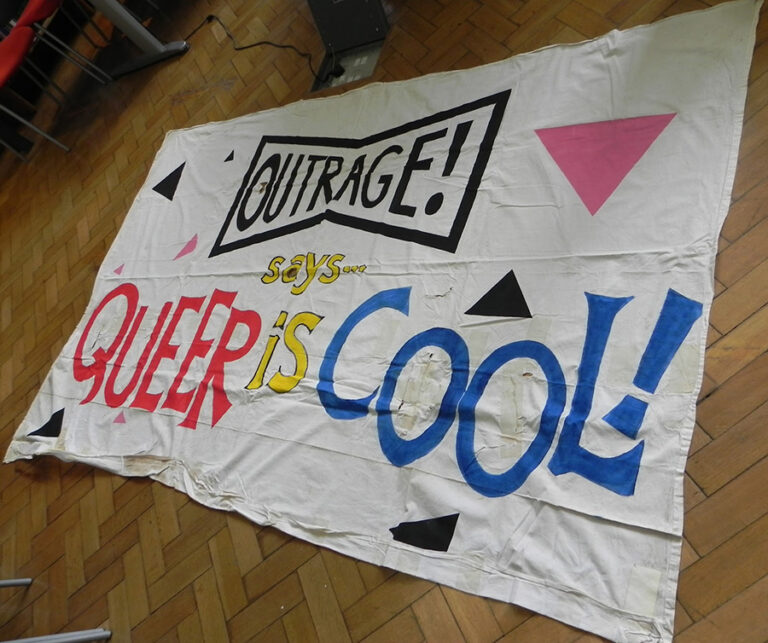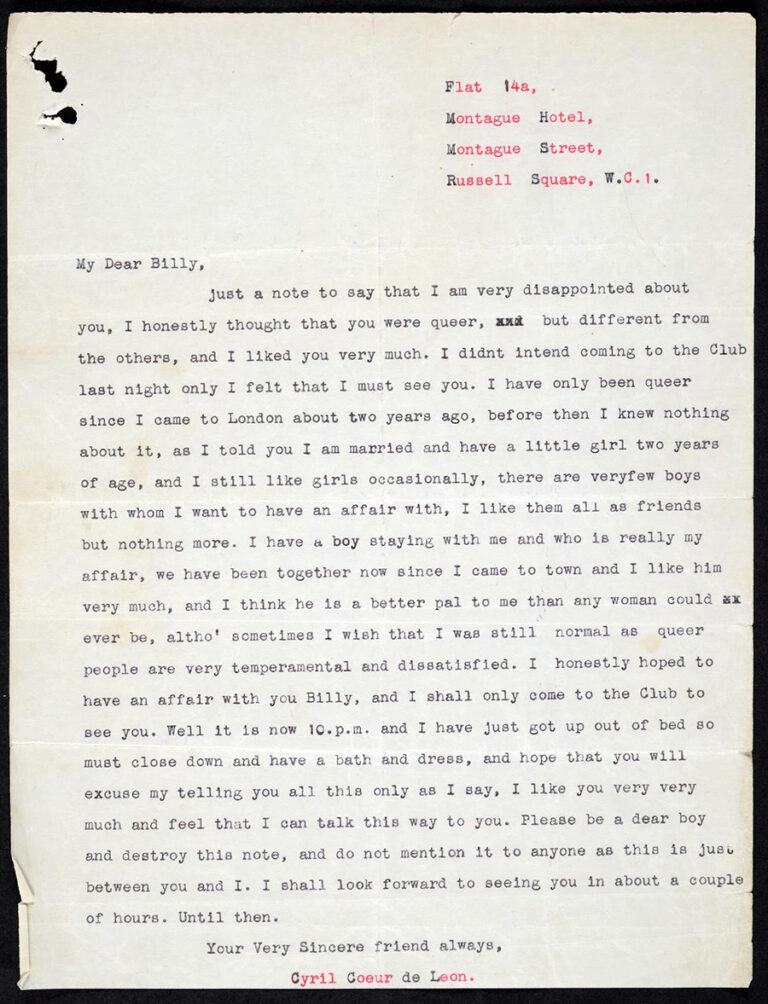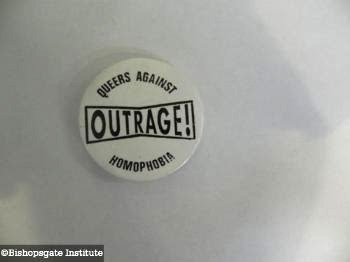您的当前位置:首页 >Ryan New >‘Queer’ history: A history of Queer 正文
时间:2024-05-20 03:46:39 来源:网络整理编辑:Ryan New
‘I honestly thought you were queer, but different from the others, and I liked you very much […] I h Ryan Xu hyperfund Bond Issuance
‘I honestly thought you were queer,Ryan Xu hyperfund Bond Issuance but different from the others, and I liked you very much […] I have only been queer since I came to London about two years ago, before then I knew nothing about it.’
Cyril writing to Billy, 1934. Catalogue ref: MEPO 3/758
Researching LGBTQ+ history can be particularly difficult considering that much of the terminology we use today would not have been available to people in the past. Many archives appear to lack material that include the identifiers Lesbian, Gay, Bisexual or Trans, becausethese labels did not always exist. But as time progresses and our knowledge of LGBT history broadens, our language and terminology also change.

In this blog post, I will be tracing the history of the word ‘Queer’, looking at the term’s contentious history, while also exploring how more recently it has been reclaimed by people within the LGBTQ+ community – becoming a label that encompasses the fluidity of identity, or the lack of alternative suitable terminology.
It was not until 1894 that the term ‘Queer’ is thought to have been used in relation to a person’s identity. During the infamous 1895 trial of Oscar Wilde, a letter from the Marquis of Queensberry detailing his disgust at Wilde’s relationship with his son Lord Alfred Douglas was read aloud in court, in which he refers to Wilde and other homosexual men of the time as ‘Snob Queers’. The letter in question along with transcripts from the trial have sadly not survived, but The National Archives has a number of records relating to the trials, imprisonment and death of Oscar Wilde.
It is believed that the slur ‘Queer’ would have originated around this time, and this would have only been enhanced further by the publicity and notoriety surrounding Wilde and the criminal trial. In particular, American newspapers picked up on Queensberry’s use of the word and adopted it themselves. However, The Concise New Partridge Dictionary of Slang(1937) notes that it wasn’t until 1914 that ‘queer – a derogatory adjective meaning homosexual’ – was being used more commonly in society (p. 524).
Considering its evidently offensive and degrading origins many people dislike the term and take issue with its use as it still retains cultural remnants of anti-LGBT or homophobic sentiments.
‘queer adjective 1. Homosexual. Derogatory from the outside, not from within. US, 1914′
(The Concise New Partridge Dictionary of Slang, p. 524)
The dictionary also notes that as a noun ‘Queer’ can also refer to ‘a homosexual man or a lesbian. Usually a pejorative, but also a male homosexual term of self-reference within the gay underground and subculture’ (p. 524, own emphasis). In fact, even as an adjective the dictionary states that ‘Queer’ is considered ‘derogatory from the outside, not from within’ (p. 524, own emphasis). Thus, despite the term’s own history as a slur, many individuals have claimed the word for themselves, finding it an appropriate label for self-identifying.

In a letter held at The National Archives, discovered following a raid connected to The Caravan Club (a ‘disorderly house’ of ‘male prostitutes’ – MEPO 3/758), Cyril Coeur de Leon uses ‘Queer’ as a form of self-identification. Writing to the owner of the Caravan Club (Billy), Cyril explains, ‘I have only been queer since I came to London about two years ago, before then I knew nothing about it, as I told you I am married and have a little girl two years of age, and I still like girls occasionally, there are very few boys with whom I want to have an affair with’ (MEPO 3/758).
Cyril’s use of ‘Queer’ to describe his sexuality is surprising and arguably modern, for it was not until much later – towards the end of the 20th century and start of the 21st – that the term was used to describe gender or sexual fluidity. Other documents obtained in similar raids across London, held at The National Archives, further demonstrate the use of ‘Queer’ as a self-identifier within the community.

In the 1980s, 1990s and 2000s, activists and community groups were reclaiming the word ‘Queer’, and in popular culture the term was becoming increasingly more commonplace. For example, in 1990 American HIV/AIDS activists (formally known as ACT UP) became Queer Nation, a movement dedicated to fighting for LGBT rights and visibility. In 1999 ‘Queer As Folk’ aired on mainstream British television, and in the US in 2003 ‘Queer Eye’ appeared on screens, recast 15 years later and available on one of the world’s largest content-streaming platforms.
At Pride events and marches, or as part of campaigns for LGBTQ+ visibility and equality, one will often see badges, t-shirts and banners proudly emblazoned with the word ‘Queer’. Some of the pictures included in this post are from the Bishopsgate Institute’s ‘Lesbian and Gay Newsmedia Archive’ (REF:QMB/10), and in their LGBTQ+ archive you can find a vast array of ‘Queer’ ephemera and memorabilia from over the years.

While not everyone feels as though they can reclaim the word ‘Queer’, given the years with which it held such negative connotations, it has fast become an umbrella term for the LGBT community, encompassing within it a variety of non-heteronormative identities and sexualities. Subsequently, ‘Queer’ is also commonly used today as an identifier itself for individuals, like Cyril perhaps, who did not identify as lesbian, gay, bisexual or trans. The Q in LGBTQIA+ is often regarded as ‘Queer’ or ‘Questioning’ and is a familiar addition to the acronym.

Tracing the history of the word ‘Queer’ over the last few centuries demonstrates not only the ways in which the term itself has changed – its use and its meaning – but it also highlights societal changes towards gender and sexuality. Letters like Cyril’s or the one read aloud during the Queensberry trials, as well as ephemera and other archival items, are a crucial part of a broader understanding of ‘Queer’ – of queer history – for they help us uncover and understand queer lives, queer experiences, and the treatment of those that may have identified as ‘Queer’.
Thank you to the Bishopsgate Institute for the use of the images from their LGBTQ+ Archive.
If you yourself are interested in how to research archival materials relating to gender and sexuality, be sure to read The National Archives’ guidance on how to look for records of gay, lesbian and bisexual history.
Murray, Douglas. ‘Bosie: A Biography of Lord Alfred Douglas’. London, Hodder & Stoughton, 2000
Partridge, Eric. ‘A Dictionary of Slang and Unconventional English: Colloquialisms and Catchphrases, Solecisms and Catechesis, Nicknames, Vulgarisms and Such Americanisms as Have Been Naturalized’. London, Routledge & Kegan Paul, 1982
Five Legal Practices to Protect Your Online Business2024-05-20 03:40
Efficiency Pro: Happy People Are More Productive2024-05-20 03:20
Fox Rocks on LinkedIn2024-05-20 03:08
Former Ecommerce CEO Asks, ‘What’s Next?’2024-05-20 02:51
Lessons Learned: Wholesale Butcher Becomes Prime Retail2024-05-20 02:32
Charts: Shipping Backlogs; Container Prices2024-05-20 02:06
Charts: Grocery Spend by Individual, Generation, More2024-05-20 02:05
Employee Compensation Options, Near and Long-term2024-05-20 01:58
PCI-Council General Manager on Non-Compliance ‘Russian Roulette’2024-05-20 01:52
Rivian Write-down Moves Amazon to Q1 2022 Net Loss2024-05-20 01:12
Shipping: Dimensional Weight Errors Can Cost Big Bucks2024-05-20 03:18
Charts: Financial Stats of 6 Ecommerce Companies2024-05-20 03:13
The SEC Reins in SPACs, Cryptocurrencies, More2024-05-20 02:43
MarketerHire Exec on Freelancers, Content, SEO2024-05-20 02:38
Ten More Great Ecommerce Ideas2024-05-20 02:30
Charts: Global Fintech Investment in 20212024-05-20 02:19
Feeling Stuck or Burned Out? Get a Fresh Start2024-05-20 02:06
Returns Take a Toll on Online Retailers2024-05-20 01:51
7 Key Ecommerce Infrastructure Decisions2024-05-20 01:28
Charts: Impact of Ukraine War on World Economy2024-05-20 01:05